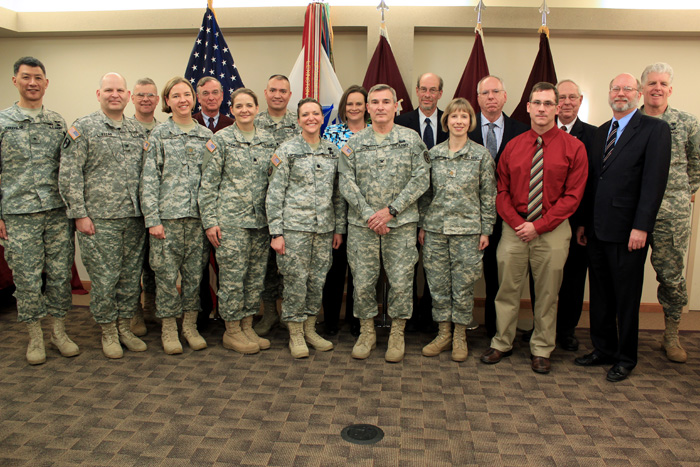USAMRMC Celebrates Successful Phase 3 Clinical Study of Cutaneous Leishmanias 'Combo Cream'

Cutaneous leishmanias. It is not generally life threatening, but it is painful, disruptive and potentially life altering with no FDA-approved treatment. While it may not be all that noticeable in the United States, it affects U.S. service members and travelers to subtropical regions of the world where it is widespread.
The U.S. Army Medical Research and Materiel Command celebrated the successful completion of its third Phase III clinical study and the announcement of the study result for Topical Paromomycin for the treatment of cutaneous leishmaniasis in the New England Journal of Medicine on the day of publication Feb. 7 at Fort Detrick.
Key speakers included Brig. Gen. (P) Joseph Caravalho, Jr., commanding general for the U.S. Army Medical Research and Materiel Command and Fort Detrick and Deputy for Medical Systems to the Assistant Secretary of the Army for Acquisition, Logistics, and Technology; and Dr. Kenneth Bertram, principle assistant for acquisition.
"Today, we recognize the completion of a pivotal four-year study in Tunisia focusing on finding an effective treatment for cutaneous leishmaniasis," said Caravalho. "Truly this research is expected to not only affect military health but also global health."
Study results for the combination cream with the antibiotics promomycin + gentamicin showed a cure rate of 81 percent in patients who participated in the trial. Patients saw shrinking of the lesions, regrowth of normal skin and the absence of relapse. A cream containing paromomycin alone had a similar cure rate of 82 percent. Only 58 percent of patients receiving placebo saw the lesions cured. Less than five percent of all study groups reporting adverse events which were primarily minor reactions at the applications site.
"This is more than just remarkable research," said Bertram. "This new investigational antibiotic cream has the potential to become a first-line treatment for cutaneous leishmaniasis that service members could apply themselves in the field."
Cutaneous leishmaniasis is a parasitic disease transmitted through the bit of an infected sandfly. The disease causes disfiguring lesions.
"Cutaneous leishmaniasis has affected more than 3,000 U.S. service members since 2003, and affects millions of people in 98 countries throughout the world," said Bertram. "In Tunisia, where the Phase III clinical trial was conducted, up to 10,000 new cases are reported each year and more than half of those cases are in children."
Current treatments are expensive, contain toxic heavy metals that must be administered either intravenously or injected directly into the lesion for a 20-day course of treatment at a medical center. For U.S. service members deployed in these areas, this often results in evacuation from their posts ' at an approximate cost of $35,000 for hospitalization, treatment and lost duty time per service member.
In the developing world, patients often resort to home remedies such as burning the lesions with anything from battery acid to a red-hot machete.
"A simple cream represents a tremendous breakthrough in the way we treat this neglected disease," said Maj. Mara Kreishman-Deitrick, product manager at the U.S. Army Medical Materiel Development Activity, which leads the advanced development of medical products for the USAMRMC.
"Let me explain why without this partnership we would not be here today," said Bertram. "We all shared a common goal ' to find a better treatment for cutaneous leishmaniasis ' but the dynamics of this unique partnership is what determined our success."
The financial support and scientific expertise for Topical Paromomycin's development was provided by scientific researchers, product managers and regulatory scientists at USAMRMC and its labs the USAMMDA and the Walter Reed Army Institute of Research.
In Tunisia, the Institut Pasteur de Tunis and the Institut Pasteur in Paris conducted clinical trials, where there was a sizeable population of cutaneous leishmaniasis patients and experienced researchers to oversee the trial.
"Each ensured the clinical trials were developed and conducted using the highest ethical and human protection standards, in compliance with international, U.S., U.S. military and Tunisian law," said Bertram.
The next step is for USAMRMC and its partners will work towards FDA approval, and then evaluating potential partners for manufacturing and distribution of the treatment.














